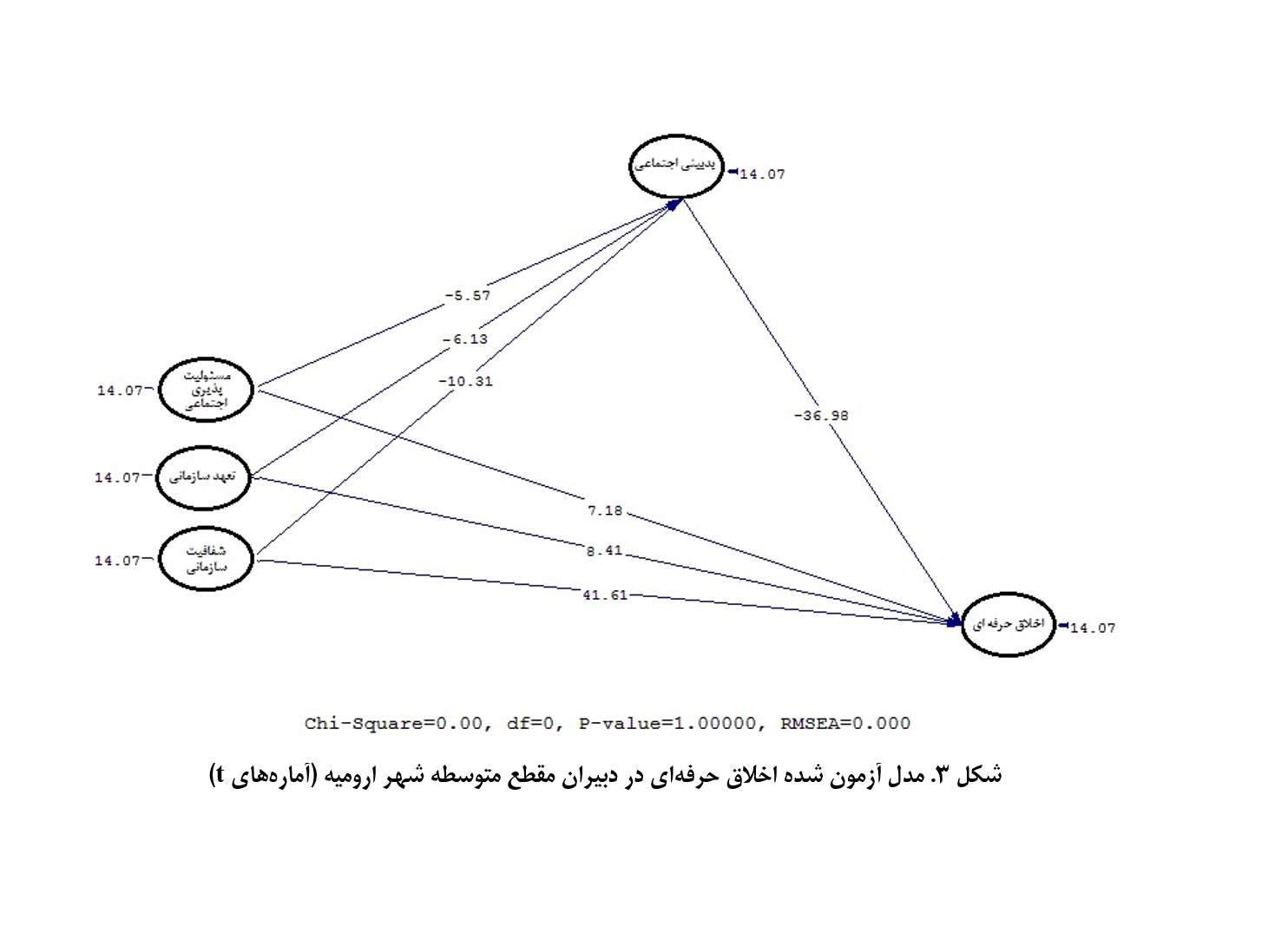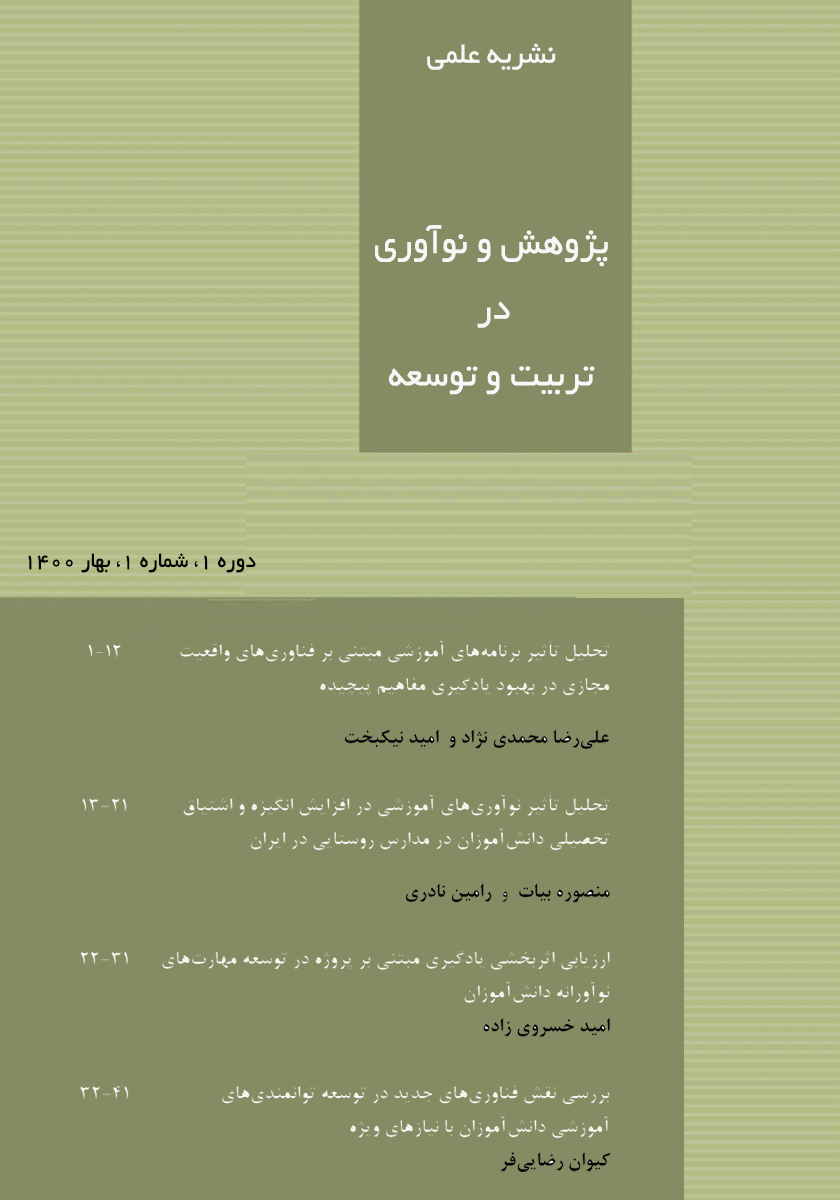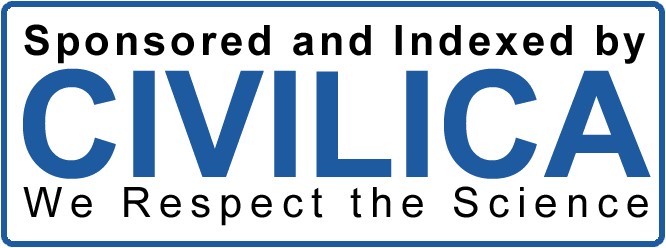مدل یابی معادلات ساختاری اخلاق حرفهای بر اساس مسئولیت پذیری اجتماعی، شفافیت سازمانی و تعهد سازمانی با میانجیگری بدبینی اجتماعی
کلمات کلیدی:
اخلاق حرفه ای, مسئولیت پذیری اجتماعی, شفافیت سازمانی, تعهد سازمانی, بدبینی اجتماعیچکیده
هدف از این پژوهش مدل یابی معادلات ساختاری اخلاق حرفهای بر اساس مسئولیت پذیری اجتماعی، شفافیت سازمانی و تعهد سازمانی با میانجیگری بدبینی اجتماعی بود. پژوهش حاضر بنیادی، غیرآزمایشی، توصیفی پیمایشی به لحاظ بررسی روابط از نوع همبستگی و معادلات ساختاری بود. جامعه آماری دبیران مقطع متوسطه شهر اورمیه در سال تحصیلی 1401-1400 بودند (2670 نفر). حجم نمونه به روش تصادفی خوشهای چندمرحلهای، با فرمول کوکران 400 نفر تعیین شد. دادههای پژوهش با پرسشنامههای، اخلاق حرفهای (قنبرپور و همکاران، 1398)، مسئولیت پذیری اجتماعی (کارول، 1991)، شفافیت سازمانی (راولینز، 2008)، تعهد سازمانی (آلن و مایر، 1990) و بدبینی اجتماعی (افشانی و کبریایی، 1399) به دست آمده و با نرم افزارهای (SPSS V. 28) و (Lisrel V. 10) تجزیه و تحلیل شدند. نتایج نشان داد که مسئولیت پذیری اجتماعی، شفافیت سازمانی و تعهد سازمانی بر بدبینی اجتماعی اثر مستقیم، منفی و معنادار دارند. مسئولیت پذیری اجتماعی، شفافیت سازمانی و تعهد سازمانی بر اخلاق حرفهای اثر مستقیم، مثبت و معنادار دارند و بدبینی اجتماعی بر اخلاق حرفهای اثر مستقیم، منفی و معنادار دارد. مسئولیت پذیری اجتماعی، شفافیت سازمانی و تعهد سازمانی بر اخلاق حرفهای با میانجیگری بدبینی اجتماعی اثر غیرمستقیم، مثبت و معنادار دارند. مسئولین امر باید با بررسی خواستههای بحق معلمان با ایجاد فضایی توام با شفافیت باعث شوند میزان تعهد معلمان و مسئولیت پذیری آنها در زمینه تدریس توسعه یابد و آنها را برای رسیدن به موفقیت و پیشرفت در امر شغلی و از طرف دیگر جامعه را در رسیدن به امر موفقیت و پیشرفت علمی کمک نمایند.
دانلودها
مراجع
Headley SAA, Melendez K. Addressing Contemporary Challenges in the Unified Code of Ethics for Health Educators.
Health Education Journal. 2020;79(4):417-30. doi: 10.1177/0017896919888556.
MacNeill K, Bolt B, Barrett E, McPherson M, Sierra M, Miller S. An Ethical Engagement: Creative Practice Research,
the Academy and Professional Codes of Conduct. Research Ethics. 2021;17(1):73-86. doi: 10.1177/1747016120915950.
Kabirian M. The Process of Professional Ethics Development in Midwifery Students: A Grounded Theory Study.
Iranian Journal of Nursing and Midwifery Research. 2024;29(3):302-8. doi: 10.4103/ijnmr.ijnmr_12_23.
Wang Y. Ethical Concepts in the Tao Te Ching and Professional Ethics Education: Principles, Challenges, and
Opportunities. The Educational Review Usa. 2024;8(2):232-6. doi: 10.26855/er.2024.02.006.
Moradi Dolisekani M, Mohammadi Mehr M. Investigating the Relationship between Professional Ethics and Teaching
Quality among Faculty Members at Army Medical University. Journal of Educational Strategies in Medical Sciences.
;13(3):150-43.
Wilson R. Ethical Issues in Teledentistry: Following the American Dental Association Principles of Ethics and Code
of Professional Conduct. The Journal of the American Dental Association. 2021;152(2):176-7. doi: 10.1016/j.adaj.2020.12.001.
Akcamete G, Kayhan N, Yildirim AES. Scale of Professional Ethics for Individuals Working in the Field of Special
Education: Validity and Reliability Study. Cypriot Journal of Educational Sciences. 2017;12(4):202-17. doi:
18844/cjes.v12i4.2902.
Guney Z. Professional Ethics in Performance and Educational Technology. Educational Policy Analysis and Strategic
Research. 2019;14(4):190-200. doi: 10.29329/epasr.2019.220.11.
Burakgazi SG, Can I, Coskun M. Exploring Pre-Service Teachers' Perceptions about Professional Ethics in Teaching:
Do Gender, Major, and Academic Achievement Matter? International Journal of Progressive Education. 2020;16(4):213-28.
doi: 10.29329/ijpe.2020.268.14.
Adda G, Azigwe JB, Awuni AR. Business Ethics and Corporate Social Responsibility for Business Success and
Growth. European Journal of Business and Innovation Research. 2016;4(6):26-42.
Liu Y, Liu S, Zhang Q, Hu L. Does Perceived Corporate Social Responsibility Motivate Hotel Employees to Voice?
The Role of Felt Obligation and Positive Emotions. Journal of Hospitality and Tourism Management. 2021;48:182-90. doi:
1016/j.jhtm.2021.06.006.
Zhang Y, Cui M. The Impact of Corporate Social Responsibility on the Enterprise Value of China's Listed Coal
Enterprises. The Extractive Industries and Society. 2020;7(1):138-45. doi: 10.1016/j.exis.2019.11.010.
Bugdayci S. Examining Personal and Social Responsibility Levels of Secondary School Students. Universal Journal
of Educational Research. 2019;7(1):206-10. doi: 10.13189/ujer.2019.070126.
Cheng WY, Cheung RYM, Chung KKH. Understanding Adolescents' Perceived Social Responsibility: The Role of
Family Cohesion, Interdependent Self-Construal, and Social Trust. Journal of Adolescence. 2021;89:55-62. doi:
1016/j.adolescence.2021.04.001.
Tymkiv N. Forming Competence of Social Responsibility in Vocational Training of Future Petroleum Engineers
(Based on Foreign Scholars' Views). Comparative Professional Pedagogy. 2018;8(3):26-30. doi: 10.2478/rpp-2018-0037.
Schiff DS, Logevall E, Borenstein J, Newstetter W, Potts C, Zegura E. Linking Personal and Professional Social
Responsibility Development to Microethics and Macroethics: Observations from Early Undergraduate Education. Journal of
Engineering Education. 2021;110(1):70-91. doi: 10.1002/jee.20371.
Carroll AB. The Pyramid of Corporate Social Responsibility: Toward the Moral Management of Organizational
Stakeholders. Business Horizons. 1991;34(4):39-48. doi: 10.1016/0007-6813(91)90005-G.
Stanic MK. Transparency in Public Relations: Evidence from Associations, Ethics Codes. Interdisciplinary
Description of Complex Systems. 2019;17(2):417-29. doi: 10.7906/indecs.17.2.15.
Holland D, Krause A, Provencher J, Seltzer T. Transparency Tested: The Influence of Message Features on Public
Perceptions of Organizational Transparency. Public Relations Review. 2018;44(2):256-64. doi: 10.1016/j.pubrev.2017.12.002.
Brandes L, Darai D. The Value and Motivating Mechanism of Transparency in Organizations. European Economic
Review. 2017;98:189-98. doi: 10.1016/j.euroecorev.2017.06.014.
Makundi F, Issund M. Survey of Organizational Transparency Studies in Scientific Articles of the Last 10 Years with
Meta-Analysis Method. Transformative Human Resources Quarterly. 2023;7(2):89-107.
Masoumi SF, Hekmati M. Organizational Transparency for Preventing Administrative and Financial Corruption (Case
Study: Hamadan Municipality). New Research Approaches in Management and Accounting Sciences. 2024;8(28):2383-97.
Albu OB, Flyverbom M. Organizational Transparency: Conceptualizations, Conditions, and Consequences. Business
& Society. 2019;58(2):268-97. doi: 10.1177/0007650316659851.
Ricardo CM, Rebeca RM. Social Responsibility and Professional Ethics in Public and Corporative Management.
Pensamiento & Gestion. 2017;42:6-25.
Ghaffarian S, Memarzadeh Tehrani G, Mohammadi N, Farahmandian A. Presenting a Model for Developing
Employee Commitment in Iranian Government Organizations. International Journal of Innovation Management and
Organizational Behavior (IJIMOB). 2024;4(3):55-67. doi: 10.61838/kman.ijimob.4.3.7.
Hermanto YB, Srimulyani VA, Pitoyo DJ. The mediating role of quality of work life and organizational commitment
in the link between transformational leadership and organizational citizenship behavior. Heliyon. 2024;10(6). doi:
1016/j.heliyon.2024.e27664.
Kanapeckaitė R. Relationships Between Team Characteristics and Soldiers’ Organizational Commitment and WellBeing: The Mediating Role of Psychological Resilience. Frontiers in Psychology. 2024;15. doi: 10.3389/fpsyg.2024.1353793.
Dwirandra A, Badera IDN, Wirawati NGP, Widhiyani NLS, Sujana IK. Role of Organizational Commitment,
Professional Ethics, Machiavellian Character, and Money Ethic in Moderating the Effect of Professionalism and Auditor
Experiences on Materiality Level Consideration. International Journal of Economic Research. 2017;14(10):259-75.
Ko J, Jang H, Kim SY. The Effect of Corporate Social Responsibility Recognition on Organisational Commitment in
Global Freight Forwarders. The Asian Journal of Shipping and Logistics. 2021;37(2):117-26. doi: 10.1016/j.ajsl.2020.12.005.
Yao T, Qiu Q, Wei Y. Retaining Hotel Employees as Internal Customers: Effect of Organizational Commitment on
Attitudinal and Behavioral Loyalty of Employees. International Journal of Hospitality Management. 2019;76:1-8. doi:
1016/j.ijhm.2018.03.018.
Cegarra-Navarro JG, Wensley AKP, Martinez-Martinez A, Garcia-Perez A. Linking Organisational Commitment with
Continuous Learning through Peripheral Vision and Procedural Memory. European Management Journal. 2020;38(6):874-83.
doi: 10.1016/j.emj.2020.05.003.
Wu CM, Chen TJ. Collective Psychological Capital: Linking Shared Leadership, Organizational Commitment, and
Creativity. International Journal of Hospitality Management. 2018;74:75-84. doi: 10.1016/j.ijhm.2018.02.003.
Allen NJ, Meyer JP. The Measurement and Antecedents of Affective, Continuance, and Normative Commitment to
the Organization. Journal of Occupational Psychology. 1990;63:1-18. doi: 10.1111/j.2044-8325.1990.tb00506.x.
Yalcin S, Akan D, Yildirim I. Investigation of the Organizational Commitment and Psychological Well-Being Levels
of Academicians. International Journal of Research in Education and Science. 2021;7(2):525-44. doi: 10.46328/ijres.1346.
Muncy JA, Iyer R. The Impact of the Implicit Theories of Social Optimism and Social Pessimism on Macro Attitudes
Towards Consumption. Psychology & Marketing. 2020;37(2):216-31. doi: 10.1002/mar.21304.
Afshani SA, Kebriayi S. From the Sense of Injustice to Social Distrust: The Double Suffering of Citizens. Journal of
Iranian Social Issues Review. 2019;10(2):27-7.
Afshani SA, Kebriayi S. Investigating the Relationship between Social Capital and Social Distrust among Citizens of
Yazd City. Journal of Social Capital Management. 2020;7(4):561-35.
Barnett MD, Anderson EA, Marsden AD. Is Death Anxiety More Closely Linked with Optimism or Pessimism among
Older Adults? Archives of Gerontology and Geriatric. 2018;77:169-73. doi: 10.1016/j.archger.2018.05.003.
Luger T, Cotter KA, Sherman AM. It's All in How You View It: Pessimism, Social Relations, and Life Satisfaction
in Older Adults with Osteoarthritis. Aging & Mental Health. 2009;13(5):635-47. doi: 10.1080/13607860802534633.
Smith TW, Ruiz JM, Cundiff JM, Baron KG, Nealey-Moore JB. Optimism and Pessimism in Social Context: An
Interpersonal Perspective on Resilience and Risk. Journal of Research in Personality. 2013;47(5):553-62. doi:
1016/j.jrp.2013.04.006.
Steenvoorden EH, Vander Meer TWG. Continent of Pessimism or Continent of Realism? A Multilevel Study into the
Impact of Macro-Economic Outcomes and Political Institutions on Societal Pessimism, European Union 2006-2012.
International Journal of Comparative Sociology. 2017;58(3):192-214. doi: 10.1177/0020715217710809.
Hasani M, Moghimi Khorasani A. The Relationship between Professional Ethics and Organizational Commitment.
Quarterly Journal of Ethics in Science and Technology. 2020;15(2):179-6.
Khajeh Hosseini M, Haji Alizadeh S, Amiri A. Investigating the Role of Professional Ethics and Accountability in
Organizational Commitment. Quarterly Journal of New Research Approaches in Management and Accounting. 2020;50:32-
Diehimpoor M, Dolati H. The Impact of Organizational Transparency on Organizational Paranoia with Social Capital
as a Mediator. Journal of Social Capital Management. 2020;7(3):398-73.
Habibi R. The Impact of Perceived Ethical Leadership Behavior on Citizenship Rights and Organizational Paranoia.
Journal of Bioethics. 2019;9(31):20-9.
Qamoshi Z, Izadi M, Mohseni Mehr Z. The Role of Faculty Members' Professional Ethics in Organizational
Transparency (Case Study: Imam Khomeini University). Higher Education Journal. 2019;12(48):64-37.
Nguyen NTT, Nguyen NP, Hoai TT. Ethical Leadership, Corporate Social Responsibility, Firm Reputation, and Firm
Performance: A Serial Mediation Model. Journal of Heliyon. 2021;7(4):e06809-1. doi: 10.1016/j.heliyon.2021.e06809.
Nemr MAA, Liu Y. The Impact of Ethical Leadership on Organizational Citizenship Behaviors: Moderating Role of
Organizational Cynicism. Cogent Business & Management. 2021;8(1):1-14. doi: 10.1080/23311975.2020.1865860.
Adeoye AO. Ethical Leadership, Employee's Commitment and Organizational Effectiveness: A Study of Non-Faculty
Members. Athens Journal of Business & Economics. 2021;7(2):161-72. doi: 10.30958/ajbe.7-2-3.
Derakhshan M, Ghanbari S, Zandi K. Factor Structure and Internal Consistency of the Organizational Transparency
Questionnaire. Quarterly Journal of Career and Organizational Counseling. 2018;10(37):164-47.

دانلود
چاپ شده
ارسال
بازنگری
پذیرش
شماره
نوع مقاله
مجوز
حق نشر 2024 نشریه پژوهش و نوآوری در تربیت و توسعه

این پروژه تحت مجوز بین المللی Creative Commons Attribution-NonCommercial 4.0 می باشد.










